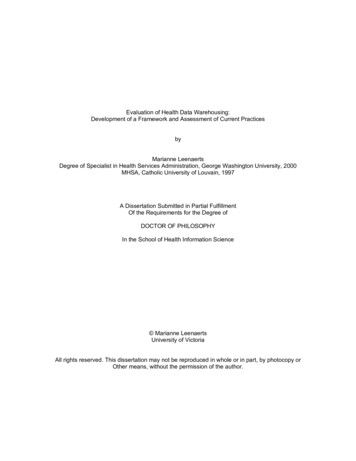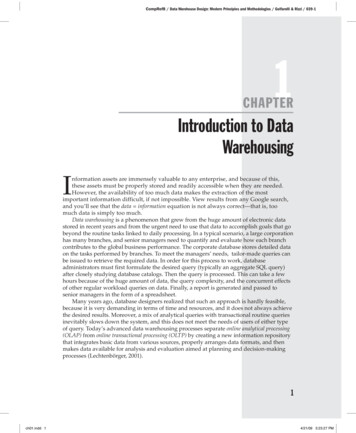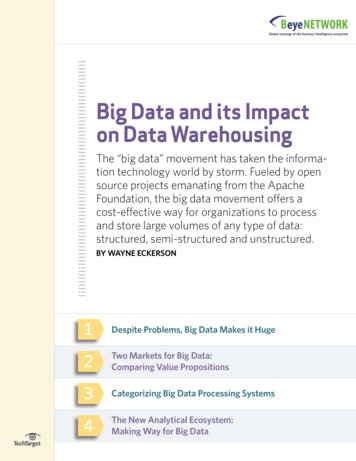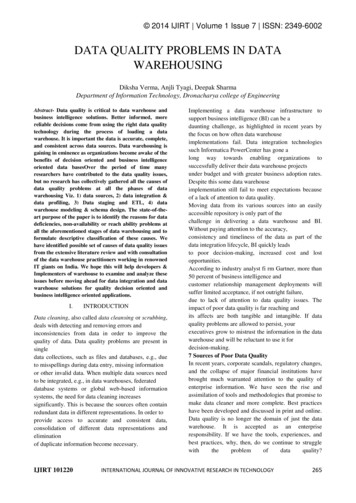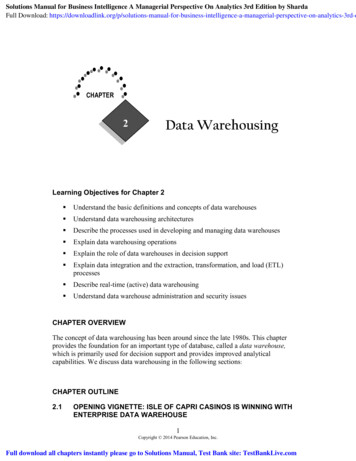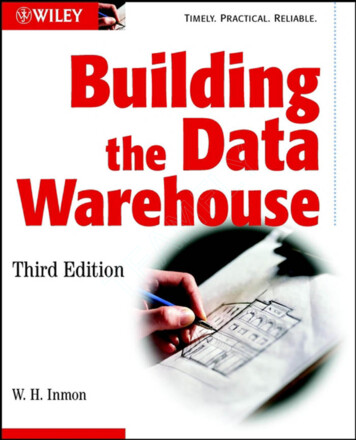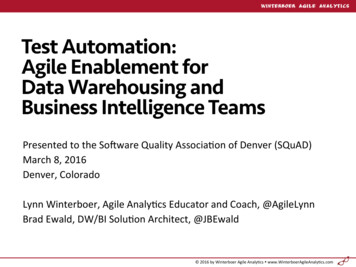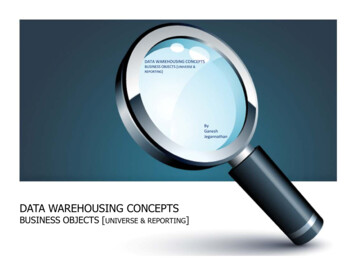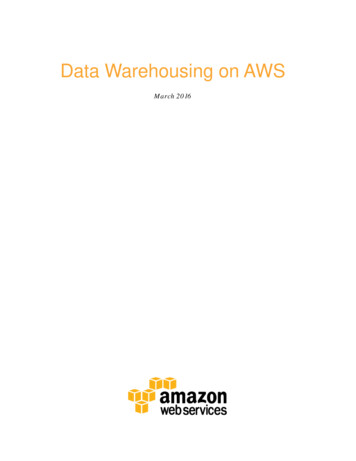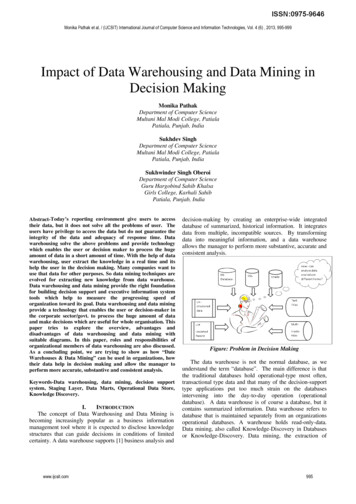
Transcription
Monika Pathak et al, / (IJCSIT) International Journal of Computer Science and Information Technologies, Vol. 4 (6) , 2013, 995-999Impact of Data Warehousing and Data Mining inDecision MakingMonika PathakDepartment of Computer ScienceMultani Mal Modi College, PatialaPatiala, Punjab, IndiaSukhdev SinghDepartment of Computer ScienceMultani Mal Modi College, PatialaPatiala, Punjab, IndiaSukhwinder Singh OberoiDepartment of Computer ScienceGuru Hargobind Sahib KhalsaGirls College, Karhali SahibPatiala, Punjab, IndiaAbstract-Today’s reporting environment give users to accesstheir data, but it does not solve all the problems of user. Theusers have privilege to access the data but do not guarantee theintegrity of the data and adequacy of response time. Datawarehousing solve the above problems and provide technologywhich enables the user or decision maker to process the hugeamount of data in a short amount of time. With the help of datawarehousing, user extract the knowledge in a real time and itshelp the user in the decision making. Many companies want touse that data for other purposes. So data mining techniques areevolved for extracting new knowledge from data warehouse.Data warehousing and data mining provide the right foundationfor building decision support and executive information systemtools which help to measure the progressing speed oforganization toward its goal. Data warehousing and data miningprovide a technology that enables the user or decision-maker inthe corporate sector/govt. to process the huge amount of dataand make decisions which are useful for whole organisation. Thispaper tries to explore the overview, advantages anddisadvantages of data warehousing and data mining withsuitable diagrams. In this paper, roles and responsibilities oforganizational members of data warehousing are also discussed.As a concluding point, we are trying to show as how “DateWarehouses & Data Mining” can be used in organizations, howtheir data help in decision making and allow the manager toperform more accurate, substantive and consistent analysis.Keywords-Data warehousing, data mining, decision supportsystem, Staging Layer, Data Marts, Operational Data Store,Knowledge Discovery.I.INTRODUCTIONThe concept of Data Warehousing and Data Mining isbecoming increasingly popular as a business informationmanagement tool where it is expected to disclose knowledgestructures that can guide decisions in conditions of limitedcertainty. A data warehouse supports [1] business analysis andwww.ijcsit.comdecision-making by creating an enterprise-wide integrateddatabase of summarized, historical information. It integratesdata from multiple, incompatible sources. By transformingdata into meaningful information, and a data warehouseallows the manager to perform more substantive, accurate andconsistent analysis.Figure: Problem in Decision MakingThe data warehouse is not the normal database, as weunderstand the term “database”. The main difference is thatthe traditional databases hold operational-type most often,transactional type data and that many of the decision-supporttype applications put too much strain on the databasesintervening into the day-to-day operation (operationaldatabase). A data warehouse is of course a database, but itcontains summarized information. Data warehouse refers todatabase that is maintained separately from an organizationsoperational databases. A warehouse holds read-only-data.Data mining, also called Knowledge-Discovery in Databasesor Knowledge-Discovery. Data mining, the extraction of995
Monika Pathak et al, / (IJCSIT) International Journal of Computer Science and Information Technologies, Vol. 4 (6) , 2013, 995-999hidden predictive information from large databases, is apowerful new technology with great potential to helpcompanies focus on the most important information in theirdata warehouses. Data mining tools predict future trends andbehaviors, allowing businesses to make proactive, knowledgedriven decisions. Data mining tools can answer businessquestions that traditionally were too time consuming toresolve. They scour databases for hidden patterns, findingpredictive information that experts may miss because it liesoutside their expectations.II. DATA WAREHOUSINGA data warehouse is a collection of integrated databasesdesigned to support a DSS. It is a collection of integrated,subject-oriented databases designed to support the DSSfunction, where each unit of data is non-volatile and relevantMemberManager/DirectorProject ManagerChief ArchitectEnd UserDatabase AdministratorApplication Programmer SpecialistSystem Administratorwww.ijcsit.comto some moment in time. Numerous roles and responsibilitieswill need to be acceded to in order to make data warehouseefforts successful and generate return on investment. For thetechnical [6] personnel (application programmer, systemadministrator, database administrator, data administrator), it isrecommended that the following roles be performed full-timeby dedicated personnel as much as possible and that eachresponsible person receive specific Data Warehouse training.The data warehouse team needs to lead the organization intoassuming their roles and thereby bringing about a partnershipwith the business. Management also needs to make actionableplans out of these directives and make sure the staff executeson them. Following are the team, team members and theirresponsibilities to make data warehouse make effective andhelpful to user and organization [2-4]:RoleThe data warehouse manager or director ensures support for the data warehouse programat the highest levels of the organization and understand high level requirements of thebusiness. Manager staff the team and ensure adherence to a set of guiding principles fordata warehousing.Project managers delivers commitments on time. Project managers maintains highlydetailed plan and caring about progress on it. Project manager matching team member’sskills and issue list of tasks to them.The Manager/Director of data warehouse will need to rely on a Chief Architect position,as one of his/her direct reports, to work on complex issues of architecture, modeling, andtools. Chief Architect would have significant interface with the internal clients andincrease their confidence in the data warehouse organization. Chief Architect shouldhave great knowledge of business.Data warehouse is made to meet end users requirements. Data warehousing is used toanswer the end users queries and generate reporting. End user receive ID and passwordon the data warehouse system and provide feedback to the data warehouse team likeperformance, functionality, data quality, metadata quality and completeness.Data warehouse group is the placement of the database administration function and thedivision of roles and responsibilities between the support group and the user community.Database administrator has many responsibilities like database maintenance, backup andrecovery, data replication, Performance Monitoring and Summary table creation.The Data Warehouse Application Programmer is responsible for applying transformationrules as necessary to keep the data clean and consistent. Application responsibilities hasmany responsibilities like sourcing the data from operational systems, applying thebusiness transformation rules.Responsibilities of system administrator are: Installing and maintaining the DatabaseManagement, monitoring the performance, architecting the data warehouse architecture.The Data Warehouse System Administrator is responsible for the performance of datatransfers, either in response to a query or as part of a data replication or synchronizationthe effort996
Monika Pathak et al, / (IJCSIT) International Journal of Computer Science and Information Technologies, Vol. 4 (6) , 2013, 995-999Data are organized based on how the users referto tile: Data are stored in read-only formatand do not change over time.Time Variant: Data are not current but normallytime series.Summarized: Operational data are mapped into adecision-usable formatLargeVolume:Timeseriesdatasetsarenormally quite large.Not Normalized: DW data can be, and often are,redundant.Metadata: Data about data are stored.Data Sources: Data come from internal andexternal unintegrated operational systems.III. ARCHITECT AND WORKING OF DATA WAREHOUSINGData warehouse is a database used for reporting and analysis.It is a place where data is stored by integrating different Databases. It can be used for storing current and historical data.With the help of historical and current database newprediction can be drawn. The following diagram [2-3] showsdifferent compounds of data warehouse.Figure: Components of Data warehouseData warehouse is a database used for reporting and dataanalysis. It is a central source of data which is created byintegrating data from one or more different sources. The datastored in the warehouse are received from the operationalsystems.The staging layer stores raw data collected from each of thedifferent source data systems. The integration layer integrateswww.ijcsit.comthe disparate data sets by transforming the data from thestaging layer often storing this transformed data in anoperational data store database.Raw Data Integrated Data Source DataWarehousing Report Decision Making.A data mart is a small data warehouse concentrated on aspecific area of interest. Data warehouses can be subdividedinto data marts for improved performance in use. Thecompany can have one or more data marts towards a largerand more complex enterprise data warehouse.A Data Warehouse saves time of business user and helps togenerate the reports quickly. Business users can quickly usethese reports on one place and can take decisions quickly.Business users won’t waste their precious time in collectingdata from multiple sources. With the help of datawarehousing, business can query the data themselves andsaves money and timeIV. DATA MININGThe data mining applications are available on allsize systems for mainframe, client/server, and PCplatforms. Data base mining or Data mining is aprocess that aims to use existing data to inventnew facts and to uncover new opment, output analysis and review.Datamining sources are typically flat files extractedfrom on-line sets of files, from data warehousesor other data source. Data may however bederived from almost any source.Whatever the source of data, data mining will often be aniterative process involving these steps. Following are thesteps[3-8] of data mining are:-.1. Uniqueness Identification of the Objective -- Before youbegin, be clear on what you hope to accomplish with youranalysis. Know in advance the business goal of the datamining. Establish whether or not the goal is measurable.2. Choice of the Data -- Once you have defined your goal,your next step is to select the data to meet this goal. This maybe a subset of your data warehouse or a data mart that containsspecific product information. It may be your customerinformation file. Segment the data as much as possible thescope of the data to be mined. Here are some key issues like1.How current and relevant are the data to the business goal?2. Are the data stable—will the mined attributes be the sameafter the analysis?3. Compilation of the Data -- Once you've assembled thedata, you must decide which attributes to convert into usableformats. Consider the input of domain experts/creators andusers of the data. Establish strategies for handling missingdata, extraneous noise, and outliers. Decide on a log or squaretransformation, if necessary. Determine the distributionfrequencies of the data?997
Monika Pathak et al, / (IJCSIT) International Journal of Computer Science and Information Technologies, Vol. 4 (6) , 2013, 995-9994. Evaluate the Data -- Evaluate the structure of your data.What is the nature and structure of the database? What is theoverall condition and distribution of the dataset?5. Choice of Appropriate Tools -- Two important factors forthe selection of the appropriate data-mining tool businessobjectives and data structure. Both should guide you to thesame tool. No single tool is preferred to answer the queries6. Prepare indented the Solution – Find out the answers ofsome questions like: What are the available format options?What is the goal of the solution? What do the end-users needgraphs, reports, code?7. Prepare the desired Model -- Now the data miningprocess begins. User split data into sets, construct and evaluatethe model. The generation of classification rules, decisiontrees, clustering sub-groups, scores, code, weights andevaluation data/error rates takes place at this stage.8. Check and Validate the Findings -- Share and discuss theresults of the analysis with the business client or domainexpert. Ensure that the findings are correct and appropriate tothe business objectives. Find out the answers of many querieslike-Do the findings make sense?9. Reporting the Findings -- Prepare a final report for thebusiness unit or client. The report should document the entiredata mining process including data preparation, tools used,test results, source code, and rules. This report helps indecision making and plays important role in the growth oforganization.10. Combine components to integrate the solution -- Sharethe findings with all interested end-users. You might wind upincorporating the results of the analysis into the company'sbusiness procedures. Although data mining tools automatedatabase analysis, they can lead to faulty findings anderroneous conclusions if you're not careful.Figure: Working of Data Mining with Data warehouseData mining can be applied to operational databases withindividual transactions. Both private and public sectors suchas banking, insurance, pharmaceutical manufacturers, healthcare providers, and retailing are using data mining for avariety of purpose to reduce costs, enhance research, predictthe effectiveness of a procedure or medicine, and increasesales.Data mining is used to predict future trends, customerpurchase habits and help in decision making. Data miningwww.ijcsit.comimprove company revenue and lower costs. Data mining isalso used in analyzing the market and find out the frauds.But data mining has many limitations too. Data mining hasprivacy or security issues. Data mining sometimes is costly atimplementation stage. Data mining has privacy issues andmisuse of information. Data mining cannot promise perfectresults, cannot explain why an outcome occurs, and cannotcorrect problems in your data.Figure: RefinementrepresentationofKnowledgewithDataV.ROLE OF DATA WAREHOUSING AND DATA MINING INDECISIONThe goal of a data warehouse is to support decision makingwith data. Data mining [9-10] can be used in conjunction witha data warehouse to help with certain types of decisions. Tobe successful, data warehousing and data mining needs askilled user who will supply the correct data and a specialistwho can make objective conclusions out of the output that iscreated. If the user supplies incorrect or minimal amount ofinformation, output will be affected and forecast will not becredible.Data warehousing and data mining plays an important role indecision making of the organization. Data warehousingprovide answers of many queries to the organization and theuser and helps in decision making. There are many types ofqueries of the organization like tactical query, strategic query,and update query.A tactical query [8] is a database operation that attempts todetermine the best course of action right now. Whereas thestrategic query provides the information necessary to makelong term business decision, a tactical query providesinformation to rank and file elements in the field that need torespond quickly to a set of unfolding events. Tactical queriestend to produce a very small result set. It is not uncommon forthe result set to be less than a dozen rows. Usually the resultset is designed to fit into a single window on a display screen.A strategic query is a database operation that attempts todetermine what has happened, why it happened, and/or whatwill happen next. It typically accesses vast amounts of detaileddata from the warehouse and ranges in complexity fromsimple table scans to multi-way joins and sub queries.Applications that generate strategic queries include; reportgeneration, OLAP, decision support, ad-hoc, data mining, etc.998
Monika Pathak et al, / (IJCSIT) International Journal of Computer Science and Information Technologies, Vol. 4 (6) , 2013, 995-999An update query is a database operation that modifies the stateof a database. Teradata provides a set of bulk load utilitiesused to load large quantities of data into the database in anefficient fashion.VI. CONCLUSIONData Mining and Warehousing talks about the change inbusiness trends these days. All the small and big industries arecollecting and using data from various sources to identify theirown business trends. Organizations understand the strengthsand the weaknesses of their competitor improve theirprogressing speed towards the goal and expand their businessempire. A data warehouse is a solution to a business problemnot a technical problem. The data warehousing and datamining need to constantly overcome obstacles that are yetundefined and help the organization in decision making andimproves the goodwill of organization. Data mining helps insecuring and processing the data into understandable chunks,where warehousing helps in analyzing the data and put it insuch a way as to facilitate comparison between trends,analyzing the data for the business predictions and acceleratedecision making. In short, a data warehousing and data miningimplementation includes the conversion of data from varioussource systems into a common format with accuracy, help theorganization in the strong business decision and help toexpand the business empire. A Data Warehouse EnhancesConsistency and Data Quality each data from the variousdepartments is standardized, each department will produceresults that are in line with all the other departments. It isrelevant and organized in an efficient manner. One powerfulfeature of data warehouses is that data from different locationscan be combined in one location.VII. FUTURE SCOPEData mining offers an important approach to achieving valuesfrom the data ware house for use in decision support. Datawarehousing becomes a standard part of an organization, therewill be efforts to find new ways to use the data. Datawarehousing and data mining will bring several newchallenges in future like 1. Regulatory constraints may limitthe ability to combine sources of disparate data. 2. Thesedisparate sources are likely to contain unstructured data whichis hard to store. 3. The internet makes it possible to access datafrom virtually “anywhere”. This just increases the disparity.Today the challenge is to design data warehousing and datamining applications that are reliable, easy to use and supportseffective decision making. As the amount of data increases inthe future, data mining and data warehousing will become avaluable tool in industries/business. Data mining [13-16] willbe helpful in finding new quality products, predict the benefitsfrom that quality data, and can help optimize use of salesresources like manpower and marketing.www.ijcsit.comREFERENCES[1]. Edwin M Knorr and Raymond T. N.( 1998), "Algorithmsfor Mining Distance-Based Outliers in Large Datasets",Proceedings of 24rd International Conference on VeryLarge Data Bases, York, USA.[2]. Brachman R. J. and Anand. T.(1996), "The process ofknowledge discovery in databases: A human centeredapproach”, chapter 2, 37-57. AAAI/MIT Press.[3]. Wirth, R. and Hipp. J.( 2000),” CRISP-DM: Towards astandard process model for data mining”, The 4thInternational Conference on the Practical Applications ofKnowledge Discovery and Data Mining, 29-39,Manchester, UK.[4]. Inmon W.H.( 1996), “Building the Data Warehouse”,Second Edition, J. Wiley and Sons, New York.[5]. Frawley W., Piatetsky Shapiro G. and Matheus C.( 1992),“Knowledge Discovery in Databases: An Overview”, AIMagazine, Fall, 213-228,.[6]. Daskalaki, S., Kopanas, I., Goudara, M., and Avouris, N.(, 2003) “Data mining for decision support on customerinsolvency in telecommunications business”, EuropeonJournal of Operational Research, Vol. 145, Issue. 2, 239255.[7]. Chen, C. and Lewis, B(2002) , “A basic primer on datamining, Information Systems Management”, 56-60.[8]. M.J.A.Berry,G. Linoff, “Data Mining Techniques: t”, second ed., Wiley, New York,2004.[9].C.X. Ling, C. Li(1998), “Data mining for directmarketing: Problems and solutions”, in Proceedings ofthe 4th International Conference on KnowledgeDiscovery and Data Mining.[10]. Berry, Michael J.A., and Gordon Linoff (1997),“ Datamining techniques: for marketing, sales, and customersupport”, New York: Wiley.[11]. S.C. Hui, G. Jha(2000), "Data Mining for CustomerService Support", Information & Management, Elsevier.[12]. Jiawei Han, Micheline Kamber, Jian Pei(2005), “DataMining: Concepts and Techniques”, 2nd edition, MorganKaufmann.[13]. J. M. Zytkow and W. Klösgen(2002), Handbook of DataMining and Knowledge Discovery. New York: Oxford.[14]. Barry, D.( 1997), “Data Warehouse from Architecture toImplementation”, Addison-Wesley.[15]. Fayyad U., Piatetsky-Shapiro G., and Smyth P.( 1996),"Knowledge Discovery and Data Mining: Towards aUnifying Framework", proceeding of 2nd InternationalConference on Knowledge Discovery and Data Mining,Portland, pp.82-88.[16]. N. R. T., Han J.( 1994), "Efficient and EffectiveClustering Methods for Data Mining", Internationalconference on Very Large Data Bases, Santiago, Chile,pp.144-15999
Data warehousing and data mining provide a technology that enables the user or decision-maker in the corporate sector/govt. to process the huge amount of data and make decisions which are useful for whole organisation. This paper tries to explore the overview, advantages and disadvantages of data warehousing and data mining with suitable diagrams.
